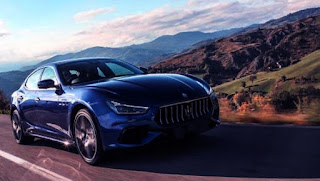The hybrid version of the Ghibli, which appeared during the restyling of the Ghibli a few months ago, marks Maserati's entry into the er...
The hybrid version of the Ghibli, which appeared during the restyling of the Ghibli a few months ago, marks Maserati's entry into the era of electrification. A cautious hybrid in reality, since behind the name lies a simple 48V system and a modest four-cylinder engine. It remains to be seen whether the sacrifice is worth it. Our test drive.
Doing like everyone else and proudly displaying electrified versions is no longer just a fad, but a must since European administrations have decided to get involved in engine design. In short, the birth of a hybrid Maserati Ghibli was dictated by accountants and tax experts. Just like the forthcoming arrival of a 100% electric version of the MC20 supercar. Nothing new in itself, most manufacturers are faced with the same calculations.
The hybrid Ghibli is therefore the first step in this gram hunt. Paradoxically, it arrives at the same time as the Ghibli Trofeo powered by the impressive 580 hp V8 discovered in the Levante! These engines will probably owe their survival to the multiplication of electric or hybrid models, to compensate for the overall CO2 balance of the range. The Ghibli Hybrid is therefore a necessary evil, purists will say.
Hybridization of Faced
That said, the mechanical base is not unknown and is already doing good work under the bonnet of an Italian cousin. In the Alfa Romeo Giulia Veloce, this engine develops 280 bhp. Be careful, it has not been grafted as is on the Ghibli: Maserati engineers would have kept only the cylinder head and the engine block, everything else being specific. The addition of a starter-alternator and an electric turbo (called e-Booster) brings the power to 330 bhp, for a maximum torque of 450 Nm. The exhaust system and sound system have also been given special attention... The aim was to make the hybridization as painless as possible.
However, the first laps of the wheels confirm what we thought: the values are close to the smallest petrol V6 (350 bhp, 500 Nm), but the plume is far from being the same. This engine is nevertheless singing, quite demonstrative at a moderate pace. Those hoping for volcanic roar and rumble worthy of the brand's 6 or 8 cylinders, those familiar with the Trident's mechanics, will be at their expense. The others will undoubtedly find the Ghibli formidable, thus rigged. All the more so as this engine is willing to beat the clock. 0 to 100 km/h in 5.7 s: here again, the figure is close to the classic V6.
Still a real GT sedan
So the picture isn't so bleak. Hybridization even brings good news: a handful of kilos less (about 20 kg), and a slightly more favorable weight distribution. Marginal, of course, for a large sedan weighing exactly 1,878 kg. No heavy batteries to carry, unlike a conventional or plug-in hybrid system.
The Ghibli therefore remains an authentic Grand Touring sedan, with all that this implies in terms of handling, agility and dynamism. No miracle to be expected, with such a mass and 4.98 m long (more imposing than the very thin stroke of a pencil gives the impression). The suspension is still a little too soft, especially at the front end. But the precise road feel, the overall feeling of this propulsion, is much more lively than the very clinical German triptych. Admittedly, the Audi A6, BMW 5 Series and Mercedes E-Class dominate the niche and objectively do better than the Ghibli in all areas. For less money. But charm and originality remain the master asset of this atypical Italian car.
Maserati first prize
The arrival of the hybrid overshadowed the very discreet restyling of the Ghibli, which took place at the beginning of summer 2020. The facelift is light, limited to the grille and the contours of the headlamps, which have barely been revised. At the rear, the crooked cut-out of the lights is a nod to the 3200 GT... Nostalgic drivers will appreciate it.





No comments